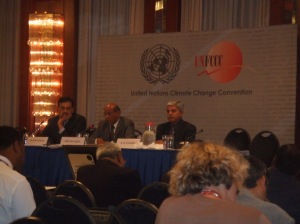Climate and Weather
Map: Aquifer zones in Chennai, Tamilnadu
Posted on 07 Aug, 2009 12:41 PMInformation may be out of date

Megh Pyne Abhiyan: Popularizing rooftop rainwater harvesting in North Bihar
Posted on 07 Aug, 2009 09:14 AMArghyam has supported a Campaign for popularizing Rooftop Rainwater Harvesting (RWH) in a flood prone region in North Bihar. The second phase of the Abhiyan has been designed based on the experiences from the first phase.
Map showing the site where river Bagmati breached its embankments in Sitamarhi, Bihar in 2009
Posted on 04 Aug, 2009 09:50 AMThe following map from South Asia Network on Dams Rivers & People gives a schematic sketch of the Bagmati Breach site near Tajpur in Bihar’s Sitamarhi district.
Rapid assessment of the flood situation at Tilak Tajpur Panchayat in Sitamarhi, Bihar
Posted on 04 Aug, 2009 09:30 AMQueries, request for information & additional clarifications can be sought via the comments section.
Download here: Rapid assessment report - Tilak Tajpur Panchayat
Pictures from the Bagmati embankment breach in Bihar in 2009
Posted on 03 Aug, 2009 10:10 AMThe google map at this URL shows Runi Sayedpur and Sitamarhi, along national highway 77: http://tinyurl.com/lxwfmj
Background documents on the Bagmati embankment breach: Article and presentation
Posted on 03 Aug, 2009 09:46 AM1) A presentation from the Central Water Commission of the Government of India studying the flood problem on the Bagmati and making some recommendations:
flood-management-in-bagmati-basin
Invitation: 3rd world climate conference (WCC-3 2009),31 Aug 2009, London
Posted on 02 Aug, 2009 08:27 PMImage and Content Courtesy: United Nations 
On behalf of the Organizing and Scientific Committee,the United Nations is pleased to invite you to participate at the 3rd World Climate Conference (WCC-3 2009). The conference is scheduled from 31 August - 4 September 2009 at the International Conference Center London, United Kingdom. Conference Theme is: "Climate prediction and information for decision-making: focusing on scientific advances in seasonal to interannual timescales, taking into account multi-decadal prediction". The WCC-3 2009 steering Committee welcomes Scientists, climate service providers, High-level policy-makers, Global business leaders,Decision-makers from the public and private sectors, Green visionaries, Academia, IO's and NGO's, Professionals in relevant fields, Women and Youth Organizations, Development Groups, Governmental Agencies, Civil Society Organizations, Community Development Organizations, Donor Agencies and Individuals working in the related field to participate and submit papers and proposals for presentation at the interactive sessions and workshops. Papers should broadly explore the conference theme. The presentations may be completed research, research in-progress or case studies, especially those reflecting innovative Green building practice. Generally the presentations will consist of a panel of three or four presenters with similar topics. Each presenter will speak for ten minutes and after all presentations are completed the floor will be opened for questions and discussions.
Meteorological datasets: Download entire datasets for various meteorological indicators from 1901 to 2002
Posted on 27 Jul, 2009 10:52 AMMeteorological data is essential for water resource planning and research. In India, this data is difficult to obtain for the average citizen. In this application, entire datasets for various meteorological indicators from 1901 to 2002, for any part of India, is made available for users, in a simple format.

The economics of climate change in Southeast Asia: a regional review
Posted on 13 Jul, 2009 09:53 AMClimate change will affect everyone but developing countries will be hit hardest, soonest and have the least capacity to respond. South East Asia is particularly vulnerable to the impacts of climate change with its extensive, heavily populated coastlines, large agricultural sectors and large sections of the population living under $2 or even $1 a day.
The “Bonn” of contention
Posted on 06 Jul, 2009 06:54 AMAs the Bonn climate talks have come to a close we would like to bid farewell to frequent long blog posts and continue to facilitate a knowledge dialogue with our negotiators and key officials who have a direct stake in the process to forming our Bonn of contention for 10-14th August when all climate leaders would be meeting again. [caption id="" align="alignleft" width="300" caption="Dr.Shyam Saran at the press conference"] [/caption] For India, since only a very limited population has its outreach in the internet world, we plan to get the word out through vernacular media into different and remote regions of India. Considering India has around 20 official languages and over 100 different dialects, we pay respect to our rich diversity by approaching outreach through radio and local language newspapers along with blogging. On 12th of June, Mr Shyam Saran was extremely unhappy with the pace at which the negotiations were proceeding, as he said so in the press conference he held at the UNFCCC negotiations. Through the various meetings at Bonn and some post Bonn meetings with some high level officials involved associated with the delegations, the following main points came through:
[/caption] For India, since only a very limited population has its outreach in the internet world, we plan to get the word out through vernacular media into different and remote regions of India. Considering India has around 20 official languages and over 100 different dialects, we pay respect to our rich diversity by approaching outreach through radio and local language newspapers along with blogging. On 12th of June, Mr Shyam Saran was extremely unhappy with the pace at which the negotiations were proceeding, as he said so in the press conference he held at the UNFCCC negotiations. Through the various meetings at Bonn and some post Bonn meetings with some high level officials involved associated with the delegations, the following main points came through:





